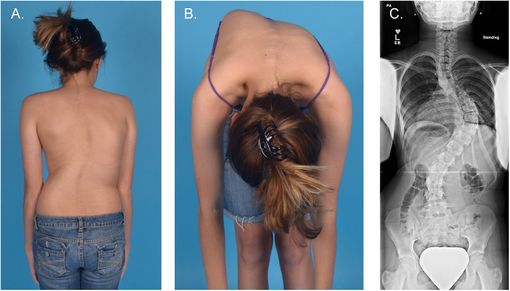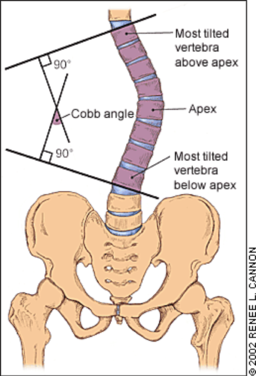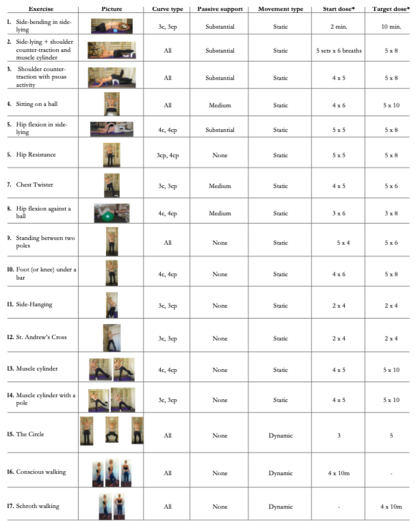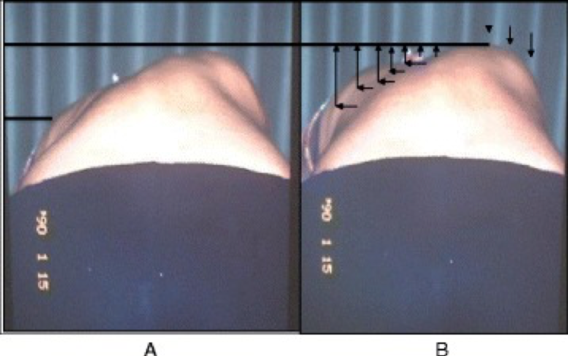Adolescent Idiopathic Scoliosis and Back Pain
Aims[edit | edit source]
This article aims to discuss the relationship between adolescent idiopathic scoliosis (AIS) (fig. 1) and back pain, and the management plan for it.
Objectives[edit | edit source]
- To introduce AIS
- To discuss the relationship between AIS and back pain, with considering of dysfunctional breathing
- To discuss the potential treatments for back pain in AIS
Introduction[edit | edit source]
Scoliosis is where the spine twists and curves to the side (National Health Service (NHS), 2017). See Scoliosis for full details.
The common outcome measure for the curvature of scoliosis is the Cobb angle (fig.2) and Risser sign.
One type of idiopathic scoliosis is AIS.
Prevalence of AIS[edit | edit source]
AIS is a common disease with an overall prevalence of 0.47-5.2 % in the current literature (Konieczny et al., 2013). It develops at the age of 11-18 and takes up 90% of idiopathic scoliosis cases in children (Konieczny et al., 2013). The female to male ratio ranges from 1.5:1 to 3:1 and increases substantially with age (Konieczny et al., 2013). Genetic factors play a role as well (Konieczny et al., 2013).
Back pain in AIS[edit | edit source]
Back pain is approximately twice as prevalent in patients with AIS compared to non-scoliosis patients (Théroux et al., 2015; Sato et al., 2011; Joncas et al., 1996).
Théroux et al (2015), Sato et al (2011) and Joncas et al (1996) reported that back pain most commonly occurred in the lumbar region followed by the thoracic region in AIS for both sexes. A statistically significant association was found between thoracic pain and thoracic scoliosis in patients with AIS as well (Théroux et al, 2015). Most AIS patients with back pain reported their pain as moderate (Théroux et al., 2015; Joncas et al., 1996) to mild (Sato et al, 2011) intensity. Sato et al. (2011) also reported that back pain in AIS lasted longer and occurred more frequently when compared to patients without scoliosis.
Back pain and Cobb angle[edit | edit source]
No statistically significant relationship was observed between pain intensity and Cobb angle severity (Théroux et al, 2015; Balagué et al., 2016). Rigo (2010) also suggested the idea that Cobb angle does not correlate with back pain. However, this paper also suggested that patients without pain tend to present smaller curves; and the incidence and intensity of back pain was higher in more severe curves (>40°-45°). The Scoliosis Research Society (SRS) (c2019) suggested that the presence of back pain may due to reduced abdominal and back strength or hamstring flexibility. However, no evidence supports this statement.
Back pain and quality of life (QoL) in AIS[edit | edit source]
Makino et al. (2015) reported that low back pain (LBP) in AIS patients can cause deterioration of patients’ QoL. Other than pain, patients' self-image such as attitude their own physical appearance is also one of the contributing factors (Makino et al., 2015) of the deterioration of QoL.
Dysfunctional breathing in AIS and back pain[edit | edit source]
Dysfunctional and asymmetrical breathing pattern often presents in patients with scoliosis (Weiss et al., 2016). Trunk rotation is increased as a result of breathing forces being directed downwards to the convexity of the spinal curvature (Weiss et al., 2016). There is also a linkage between dysfunctional breathing and LBP (Chaitow, 2014; Kiesel et al., 2017) and neck pain (Kiesel et al., 2017).
Treatment[edit | edit source]
This section will cover the direct or indirect conservative and surgical treatment for back pain in AIS.
Conservative treatment[edit | edit source]
Schroth method[edit | edit source]
The Schroth method is a set of exercises which is specifically designed for patients with scoliosis, especially for idiopathic scoliosis (Berdishevsky et al., 2016). It is developed by Katharina Schroth in Germany (Kim et al., 2017).
Schroth method aims at preventing curve progression before the end of growth with the following goals:
- Proactive spinal corrections to avoid surgery
- Postural training to avoid or decelerate progression
- Information to support a decision-making process
- Teaching a home-exercise programme
- Support help for self-help
- Prevention and coping strategies for pain
(Berdishevsky et al., 2016)
Evidence for the effectiveness of Schroth method exercises[edit | edit source]
Schreiber et al. (2015)
Schreiber et al. (2015) did a randomised controlled trial (RCT) which suggested that Schroth method exercises with standard care improved pain in patients with AIS over a 6-month intervention. Table 1 shows the participants, intervention, comparison, outcomes (PICO) model of the study.
| Participants | Intervention | Comparison | Outcomes |
|---|---|---|---|
50 patients
|
25 patients
|
25 patients
|
Collected at baseline, 3 and 6 months
|
* SRS-22r is a scoliosis-related QoL questionnaire that assesses five domains: function, pain, self-image, mental and satisfaction with care. Each question is scored from 1 to 5, where 1 is the worst, and 5 the best.
Results
- The intervention group has a better improvement overall in terms of SRS-22r pain score
- SRS-22r pain score difference between the two groups from baseline to 3 months was not statistically significant: -29.16; p=0.45
- Schroth group has significant improvement in SRS-22r pain score from 3 to 6 months when compared to the control group: 85.25; p=0.02
Table 2 shows the results of the study.
| Outcome | Intervention group (n=25) | Control group (n=25) | 0 to 3 months difference in change between group | 3 to 6 months difference in change between groups | ||
|---|---|---|---|---|---|---|
| Mean | Standard errors | Mean | Standard errors | p-value | p-value | |
| SRS-22r (pain): baseline | 422.84 | 31.53 | 348.63 | 31.36 | 0.45 | - |
| SRS-22r (pain): 3 month | 460.76 | 32.37 | 415.71 | 32.62 | 0.02 | |
| SRS-22r (pain): 6 month | 525.99 | 33.38 | 395.68 | 32.36 | - | |
SRS-22r=Scoliosis Research Society-22r
Strengths
- The assessors and the statistician were blinded to the treatment allocation
- Standardised treatment by developing the classification and exercise prescription algorithms
- Specific exercise prescription for each curve type (fig. 3)
Limitations
- Only overall pain was measured
- The therapists, patients and accessors could not be blinded to the exercises in which they were involved
- Pain is a subjective outcome
- RCT is not at the top of the hierarchy of evidence
Lee et al. (2016)
Lee et al. (2016) did a case study which showed a decrease in pain and Cobb’s angle in all subjects after applying the Schroth method with emphasis on active holding. Table 3 shows the PICO model of the study and table 4 shows the results of it.
| Participants | Intervention | Comparison | Outcomes |
|---|---|---|---|
3 patients
|
3 patients
|
Patients baseline before intervention |
|
| Subject no. | Subject characteristics | Results | |||
|---|---|---|---|---|---|
| VAS | Cobb angle | ||||
| Pre-test | post-test | Pre-test | post-test | ||
| 1 |
|
4 | 0 | 20° | 10.8° |
| 2 |
|
8 | 0 | 20.3° | 4° |
| 3 |
|
8 | 3 | 30.6° | 18.5° |
LBP=low back pain; VAS=visual analogue scale
Limitations
- A very small sample size
- Case study is not considered as the “best evidence” as it is low in terms of level of evidence
- No detailed description about the Schroth method program with emphasis of active holding
- Participants presented with different pain and underlying conditions
- Long term effects were not measured, the benefits might be temporary
- Not addressing directly to AIS patient, patients were all over 18
Breathing retraining and exercises[edit | edit source]
There are evidence suggesting the use of breathing exercises as a treatment for chronic LBP (Anderson et al., 2017). This review included 3 RCTs of medium quality with reference to the Physiotherapy Evidence Database (PEDro) scale (Liao et al., 2018). The searches were conducted across 5 databases and 10 years (2005-2015). However, one thing to note is that the patients included in the studies may not have scoliosis and this review is not specific to adolescents.
Rotational Angular Breathing (RAB)[edit | edit source]
Schroth method is considered to be more effective than manual treatments because of its three-dimensional nature and its rotational angular breathing (RAB) component (Kim et al., 2017). It ‘helps in vertebral and rib cage derotation and in increasing vital capacity’ (Berdishevsky et al., 2016).
RAB helps expand the ribcage by pushing the ribs ‘sideways and backwards’ and helps return the vertebrae closer to their normal, untwisted position (Berdishevsky et al., 2016) (fig. 4) (see video below).
Equipment such as wall bars and elastic bands can also be used with RAB as part of the Schroth’s exercises. It can be done in different position like forward bending, sitting and side-lying (see videos below).
Respiratory muscle exercises[edit | edit source]
The RCT done by Kim et al. (2017) has shown that breathing muscle strengthening can improve both Cobb angle and respiratory function (Kim et al., 2017). Table 5 shows the PICO model of the study and table 6 shows the results of it.
| Participants | Intervention | Comparison | Outcomes |
|---|---|---|---|
15 patients
|
8 patients
|
7 patients
|
|
| Cobb angle (°) | Intervention group (n=8) | Controlled group (n=7) | Independent t-test |
|---|---|---|---|
| Pre-test (mean±SD) | 24.49±8.32 | 27.16±12.44 | -0.495 |
| Post-test (mean±SD) | 20.23±7.54 | 24.47±12.45 | -0.810 |
| Difference (mean±SD) (p-value) | 4.26±1.36 (p<0.05) | 2.69±1.11 (p<0.05) | 2.415 (p<0.05) |
SD=statistical difference
Strength
- PEDro scale: 7/10 (high quality (Liao et al., 2018))
Limitations
- Unknown external validity and clinical significance
- Unknown minimally clinical important difference for Cobb angle
- High risk of type 2 error
- Small sample size
- Questionable internal validity
- Unknown blinding conditions
- Lack of evidence for using SpiroTiger as respiratory muscle exercises
- Uncertain relationship between Cobb angle and pain, although breathing exercises have been used to treat LBP in other studies (Anderson et al., 2017)
Braces[edit | edit source]
Negrini et al., 2015 did a systematic review on the use of braces on back pain in AIS. Out of the seven studies, there is only one that measured back pain and it suggested that bracing did not have an effect on back pain in long term (Negrini et al., 2015). However, the evidence included in this review is of very low quality (Negrini et al., 2015).
Another systematic review done by Balagué et al. (2016) suggested that bracing has no influence on back pain when compared to the observation group. However, conflicting evidence was reported in this review (Balagué et al., 2016).
Osteopathic manipulation[edit | edit source]
There is currently no evidence to support osteopathic manipulation as the treatment for AIS (Balagué et al., 2016).
Taping[edit | edit source]
Atici et al. (2017) suggested Kinesio Taping decreases back pain and increases the QoL in patients with type 1 AIS under the Lenke classification of scoliosis. This is a RCT and the only study on Kinesio Taping for AIS. Therefore, there is insufficient evidence.
Surgical treatment for AIS[edit | edit source]
Surgery may be recommended if the scoliosis is worsening and other treatments are ineffective, or the scoliosis is severe and the adolescent has stopped growing (NHS, 2017).
In general, surgical treatments are indicated when the Cobb angle (degree of curvature of the spine) is greater than 45 to 50 degrees (Maruyama et al., 2009).
Posterior fusion with instrumentation is usually performed for idiopathic scoliosis (Maruyama et al., 2009).
Conclusion[edit | edit source]
Back pain is very common in AIS, which can affects the QoL of patients. There are many contributing factors for the presence of back pain in AIS, including altered anatomy and breathing pattern. Current evidence mainly suggests the use of Schroth's method with RAB as a treatment for back pain in AIS.
References[edit | edit source]
alanaInformFitness. 2011. SpiroTiger Demo with Lachlan Davey_0001.wmv. [Online]. Available at: https://www.youtube.com/watch?v=EvqzAPqh6HE. [Accessed on 23rd May 2019].
Align Therapy. 2018. What are Schroth Method Exercises for Scoliosis?. [Online]. Available at: https://www.youtube.com/watch?v=cmWYhpT6Qfk. [Accessed on 23rd May 2019].
Anderson, B. E. and Bliven, K. C. H. (2017). The Use of Breathing Exercises in the Treatment of Chronic, Nonspecific Low Back Pain. Journal of Sport Rehabilitation. 26 (5), pp. 452-458.
Atici, Y., Aydin, C., Atici, A., Buyukkuscu, M., Arikan, Y. and Balioglu, M. (2017). The effect of Kinesio taping on back pain in patients with Lenke Type 1 adolescent idiopathic scoliosis: A randomized controlled trial. Acta Orthopaedica et Traumatologica Turcica. 51 (3), pp.191-196.
Balagué, F. and Pellisé, F. (2016). Adolescent idiopathic scoliosis and back pain. Scoliosis and Spinal Disorders. 11 (1), pp. 27.
Berdishevsky, H., Lebel, V. A., Bettany-Saltikov, J., Rigo, M., Lebel, A., Hennes, A., Romano, M., Białek, M., M’hango, A., Betts, T., de Mauroy, J. C. and Durmala, J. (2016). Physiotherapy scoliosis-specific exercises – a comprehensive review of seven major schools. Scoliosis and Spinal Disorders. 11 (20), [no pagination].
Chaitow, L. (2004). Breathing pattern disorders, motor control, and low back pain. Journal of Osteopathic Medicine. 7 (1), pp. 33-40.
Greiner, K. A. 2002. Adolescent Idiopathic Scoliosis: Radiologic Decision-Making. American Family Physician. 65 (9), pp. 1817-1823.
Joncas, J., Labelle, H., Poitras, B., Duhaime, M., Rivard, C. and Le Blanc, R. (1996). Dorso-lumbal pain and idiopathic scoliosis in adolescence. Annales de Chirurgie. 50 (8), pp. 637-640.
Kiesel, K. Rhodes, T., Mueller, J., Waninger, A. and Butler, R. (2017). Development of a Screening Protocol to identify individuals with dysfunctional breathing. International Journal of Sports Physical Therapy. 12 (5), pp. 774-786.
Kim, M. and Park, D. (2017). The effect of Schroth’s three-dimensional exercises in combination with respiratory muscle exercise on Cobb’s angle and pulmonary function in patients with idiopathic scoliosis. Physical Therapy Rehabilitation Science. 6 (3), pp. 113-119.
Konieczny, M., Senyurt, H. and Krauspe, R. 2013. Epidemiology of adolescent idiopathic scoliosis. Journal of Children´s Orthopaedics. 7 (1), pp. 3-9.
Lee, H., Seong, H., Bae, Y., Jang, H., Chae, S., Kim, K. and Lee, S. (2016). Effect of the Schroth method of emphasis of active holding on Cobb’s angle in patients with scoliosis: a case report. Journal of Physical Therapy Science. 28(10), pp.2975-2978.
Liao, C., Xie, G., Tsauo, J., Chen, H. and Liou, T. (2018). Efficacy of extracorporeal shock wave therapy for knee tendinopathies and other soft tissue disorders: a meta-analysis of randomized controlled trials. BMC Musculoskeletal Disorders. 19 (278), [no pagination].
Makino, T., Kaito, T., Kashii, M., Iwasaki, M. and Yoshikawa, H. (2015). Low back pain and patient-reported QOL outcomes in patients with adolescent idiopathic scoliosis without corrective surgery. SpringerPlus. 4 (1), pp. 397.
Maruyama, T. and Takeshita K. 2009. Surgery for Idiopathic Scoliosis: Currently Applied Techniques. Clinical Medicine: Pediatrics. 3 (2009), pp. 39-44.
Negrini, S., Minozzi, S., Bettany-Saltikov, J., Chockalingam, N., Grivas, T., Kotwicki, T., Maruyama, T., Romano, M. and Zaina, F. (2015). Braces for idiopathic scoliosis in adolescents. Cochrane Database of Systematic Reviews. [Online]. Issue 6, art. no.: CD006850. Available at: https://doi.org/10.1002/14651858.CD006850.pub3. [Accessed on 23rd May 2019].
NHS. (2017). Scoliosis. [Online]. Available at: https://www.nhs.uk/conditions/scoliosis/. [Accessed on 22nd May 2019].
NHS. (2017). Treatment in children - Scoliosis. [Online]. Available at: https://www.nhs.uk/conditions/scoliosis/treatment-in-children/. [Accessed on 22nd May, 2019].
Paria, N. and Wise, C. A. 2015. Genetics of adolescent idiopathic scoliosis. Seminars in Spine Surgery. 27 (1), pp. 9-15.
Rigo, M. (2010). Differential diagnosis of back pain in adult scoliosis (non operated patients). Scoliosis. 5 (S1), pp. O44.
Sato, T., Hirano, T., Ito, T., Morita, O., Kikuchi, R., Endo, N. and Tanabe, N. (2010). Back pain in adolescents with idiopathic scoliosis: epidemiological study for 43,630 pupils in Niigata City, Japan. European Spine Journal. 20 (2), pp. 274-279.
Schreiber, S., Parent, E., Moez, E., Hedden, D., Hill, D., Moreau, M., Lou, E., Watkins, E. and Southon, S. (2015). The effect of Schroth exercises added to the standard of care on the quality of life and muscle endurance in adolescents with idiopathic scoliosis—an assessor and statistician blinded randomized controlled trial: “SOSORT 2015 Award Winner”. Scoliosis, 10 (1), pp.24
Scoli-Fit NYC Scoliosis Systems LLP. 2015. Directional Breathing Band. [Online]. Available at: https://www.youtube.com/watch?v=xGUojrDPkP4. [Accessed on 23rd May 2019].
Scoliosis Care Centers. 2010. Adams Test and Schroth Breathing Exercise for Scoliosis Treatment. [Online]. Available at: https://www.youtube.com/watch?v=dyNrxq-PKmQ. [Accessed on 23rd May 2019].
Scoliosis Research Society. (c2019). Adolescent Idiopathic Scoliosis. [Online]. Available at: https://www.srs.org/patients-and-families/conditions-and-treatments/parents/scoliosis/adolescent-idiopathic-scoliosis. [Accessed 21 May 2019].
Théroux, J., Le May, S., Fortin, C. and Labelle, H. (2015). Prevalence and Management of Back Pain in Adolescent Idiopathic Scoliosis Patients: A Retrospective Study. Pain Research and Management. 20 (3), pp. 153-157.
Weiss, H., Moramarco, M. M., Borysov, M., Ng, S. Y., Lee, S. G., Nan, X. and Moramarco, K. A. (2016). Postural Rehabilitation for Adolescent Idiopathic Scoliosis during Growth. Asian Spine Journal. 10 (3), pp. 570-581.










